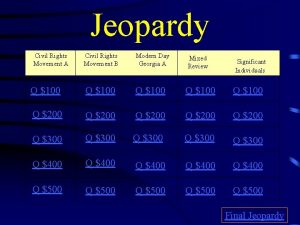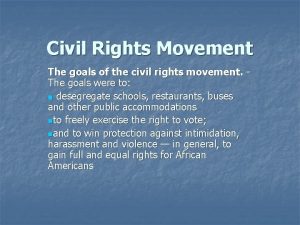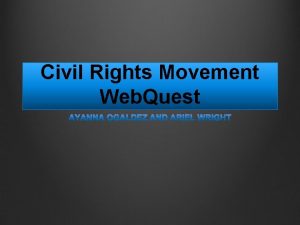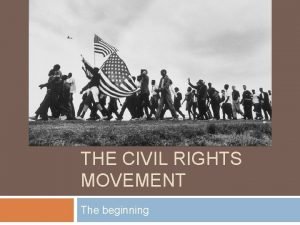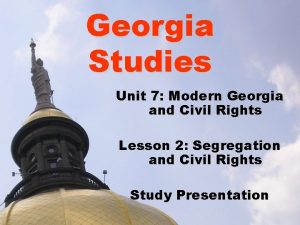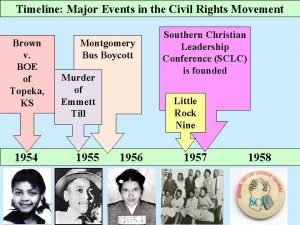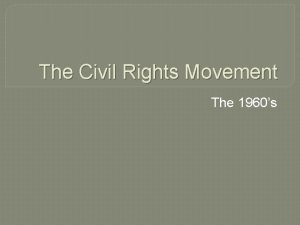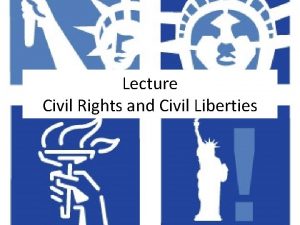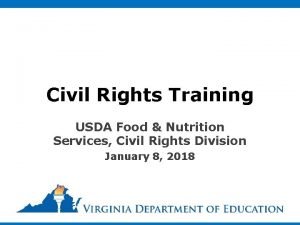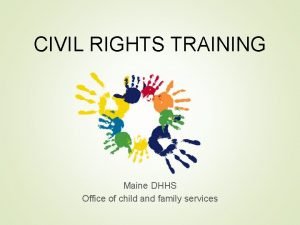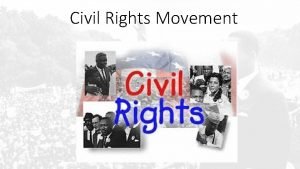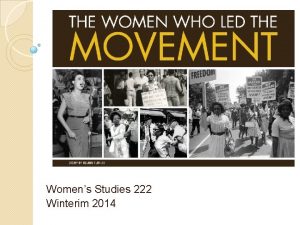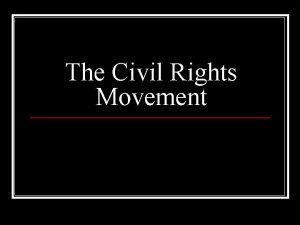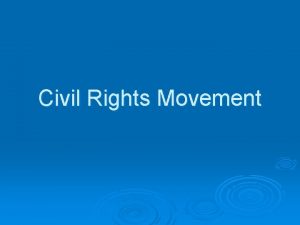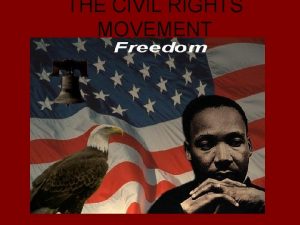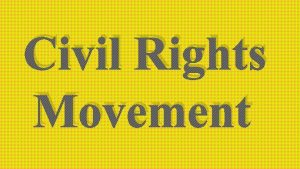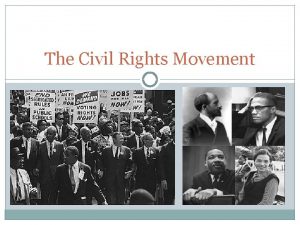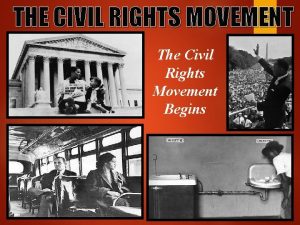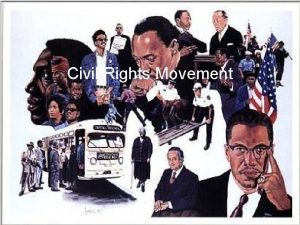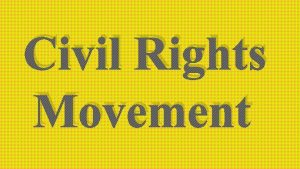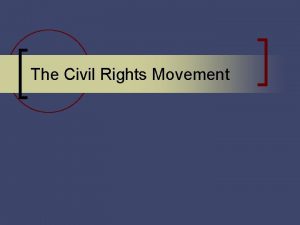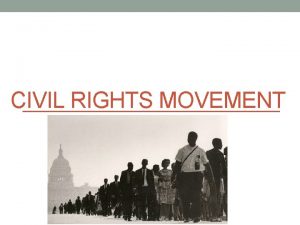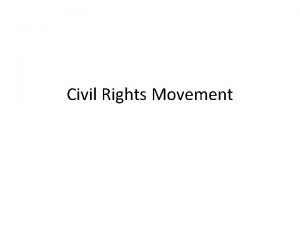Modern Civil Rights Movement WMNS 222 Winterim 2014

















- Slides: 17

Modern Civil Rights Movement WMNS 222 Winterim 2014

1954: Brown v. Board of Education The Supreme Court declares school segregation unconstitutional in Brown v. Board of Education in Topeka, Kansas. This decision overturned the 1896 Plessy v. Ferguson ruling that sanctioned “separate but equal” segregation of the races.

1955: Emmet Till Murder Fourteen-year-old Chicagoan Emmet Till is kidnapped, beaten, shot, and dumped in the Tallahatchie River for allegedly whistling at a white woman while visiting Mississippi. Two white men, J. W. Milam and Roy Bryant were arrested for the murder and acquitted by an all-white jury. They later boast about the murder in a magazine interview. His mom, Mamie Till-Mobley, insisted on having Emmett's mutilated body returned to Chicago, where she had an open-casket funeral for him. A picture of Emmett's mutilated, bloated face was shown around the country and was one of the sparks of the Civil Rights Movement.

1955: Rosa Parks and The Montgomery Bus Boycott Rosa Parks is put in jail for refusing to move to the back of the bus in Montgomery, Alabama. The Montgomery Bus Boycott continued from December 1, 1955 to December 20, 1956. Rosa Parks was actually sitting in the front row designated for African American individuals, but the expectation was that those seats must be surrendered to whites when there weren’t available seats. When Parks refused to surrender her seat, she was arrested.

1956: The Supreme Court ruling on Browder v. Gayle declared segregated buses to be unconstitutional. � About two months after the bus boycott began, civil rights activists reconsidered the case of Claudette Colvin. She was a 15 -year-old girl who had been the first person arrested in 1955 for refusing to give up her seat on a Montgomery bus, nine months before Rosa Parks' action. Fred Gray, E. D. Nixon, president of the NAACP and secretary of the new Montgomery Improvement Association; and Clifford Durr (a white lawyer who, with his wife Virginia, was an activist in the civil rights movement) searched for the ideal case law to challenge the constitutional legitimacy of Montgomery and Alabama bus segregation laws. � Durr was concerned that an appeal of Mrs. Rosa Parks' case would get tied up in the Alabama state courts and thought they needed a way to get directly to federal courts. Gray did research for the lawsuit, consulting with NAACP legal counsels Robert Carter and Thurgood Marshall (who would later become United States solicitor general and a United States Supreme Court justice), respectively. Gray approached Colvin, Aurelia Browder, Susie Mc. Donald, Mary Louise Smith and Jeanette Reese, all women who had been discriminated against by drivers enforcing segregation policy in the Montgomery bus system. They agreed to become plaintiffs in a federal civil action lawsuit, thus bypassing the Alabama court system. (Jeanette Reese dropped out of the case in February 1956 because of intimidation by members of the white community. )

1956: The Supreme Court issues Brown II to relieve hardships caused by immediate desegregation. In this ruling, the Supreme Court asserted that school integration should proceed “with all deliberate speed. ” This language enabled school districts to delay significant integration for years.

1956: First African American admitted to University of Alabama. Autherine Juanita Lucy was the first black student to attend the University of Alabama, in 1956. She attended Selma University in Selma, and the all-black Miles College in Fairfield - where she graduated with a BA in English in 1952. Later in 1952, at the encouragement of and along with a Miles classmate, Pollie Ann Myers, she decided to attend the University of Alabama as a graduate student but, knowing that admission would be difficult due to the University's admission policies, she and Myers approached the National Association for the Advancement of Colored People (NAACP) for help. Thurgood Marshall, Constance Baker Motley, and Arthur Shores were assigned to be their attorneys. While they started preparing her case, she worked as a secretary. Court action began in July 1953. On June 29, 1955, the NAACP secured a court order preventing the University from rejecting the admission applications of Lucy and her friend based upon their race. Days later, the court amended the order to apply to all other African-American students seeking admission. The Supreme Court upheld this in Lucy v. Adams on October 10, 1955. On the very eve of the day Lucy and her friend (who had married to become Pollie Myers Hudson) were to register, the University Board of Trustees rejected Hudson on the grounds of her "conduct and marital record", but reluctantly allowed Lucy to register. On February 3, 1956, Lucy enrolled as a graduate student in library science, becoming the first African American ever admitted to a white public school or university in the state. On the third day of classes, a hostile mob assembled to prevent Lucy attending classes. The police were called to secure her admission but, that evening, the University suspended Lucy on the grounds that it could not provide a safe environment. Lucy and her attorneys filed suit against the University to have the suspension overturned. However, this suit was not successful and was used as a justification for her permanent expulsion. University officials claimed that Lucy had slandered the university and they could not have her as a student. The University of Alabama finally overturned her expulsion in 1980, and in 1992, she earned her Masters degree in Elementary Education from the University that she had applied to decades earlier.

1957: Little Rock Central High Crisis NAACP registers nine black students to integrate Little Rock Central High School: Ernest Green, Elizabeth Eckford, Jefferson Thomas, Terrence Roberts, Carlotta Walls, Minnijean Brown, Gloria Ray, Thelma Mothershed and Melba Pattillo Arkansas Governor Orval Faubus uses the National Guard to block nine black students from attending Little Rock Central High School. President Eisenhower sent federal troops to allow the black students to enter the school.

Little Rock Crisis Timeline � Sept. 4: Little Rock Nine try to enter the building and are turned away by National Guard, called in by � � � Gov. Orval Faubus Sept. 9: Judge Ronald Davies of the U. S. District Court for the Eastern District of Arkansas begins injunction proceedings against the governor and two National Guardsmen for interfering with integration Sept. 14: Faubus meets with President Dwight D. Eisenhower in Newport, R. I. Sept. 20: Judge Davies grants NAACP lawyers Thurgood Marshall and Wiley Branton an injunction telling Faubus to withdraw the National Guard Sept. 23: Little Rock police slip students into the school earlier than scheduled to bypass protesters. When crowd of more than 1, 000 white protesters realizes what happened, it begins rioting. The outnumbered police officers escort the Little Rock Nine out of the school Sept. 24: Eisenhower sends 101 st Airborne Division of the U. S. Army to Little Rock Sept. 25: Little Rock Nine successfully enter the school Nov. 27: 101 st leaves Little Rock 1958: Little Rock Nine receive NAACP's Spingarn Medal May 8: Eisenhower orders federalized National Guard removed from Central High School May 27: The oldest Little Rock Nine student, Ernest Green, is the first black student to graduate from Central High September: Faubus signs a recently passed law allowing him to close Little Rock public senior high schools, forcing all students to study elsewhere June 1959: A federal court rules Faubus' actions unconstitutional, forcing him to reopen the schools.

1957: Southern Christian Leadership Conference Forms 1957: The Southern Christian Leadership Conference is established at meetings in January. Founders: Joseph Lowery, Fred Shuttlesworth, Martin Luther King, Jr. , Bayard Rustin, Ralph Abernathy. Ella Baker is the first staff member. The SCLC became a major force in organizing the Civil Rights movement and based its principles on nonviolence and civil disobedience. At a meeting in New Orleans, Louisiana on February 14, 1957. The organization shortened its name to Southern Leadership Conference, established an Executive Board of Directors, and elected officers, including Dr. Martin Luther King, Jr. as President, Dr. Ralph David Abernathy as Financial Secretary-Treasurer, Rev. C. K. Steele of Tallahassee, Florida as Vice President, Rev. T. J. Jemison of Baton Rouge, Louisiana as Secretary, and Attorney I. M. Augustine of New Orleans, Louisiana as General Counsel.

1957: The Civil Rights Act of 1957 On August 29, 1957, President Dwight Eisenhower signed the Civil Rights Act of 1957 into law. One of the main goals of the act was to help ensure that all African-Americans were ensured their right to vote. It set up the Civil Rights Commission to monitor civil rights abuses. Unfortunately, the bill lost a lot of its teeth due to opposition from southern Democrats. The resulting bill was not universally lauded as many such as Ralph Bunche felt it was worthless in achieving its aims. However, it became the first of many bills and measures to help fight against Jim Crow laws and anti-voting actions in the South.

1960: John F. Kennedy wins the presidential election. He is the first and only Catholic president, the first Irish. American president, and the only president to have won a Pulitzer Prize. Kennedy verbally supported racial integration and civil rights, although the political priority was to keep the president out of the civil rights struggles to avoid making it more difficult to pass laws through a Congress dominated by conservative Southern Democrats.

1960 Sit-In Movement Begins On February 1 st four black college students begin sit-ins at the lunch counter of a Woolworth’s store in Greensboro, North Carolina, where black patrons were not served. Although they were refused service, they were allowed to stay at the counter. This event triggered many similar protests throughout the south. Six months later, these original four protesters were served lunch at the same Woolworth’s counter.

1960: The Student Nonviolent Coordinating Committee founded The Student Nonviolent Coordinating Committee is founded at Shaw University. It emerged from a student meeting organized by Ella Baker held at Shaw University on April 17, 1960. SNCC grew into a large organization with many supporters in the North who helped raise funds to support SNCC's work in the South, allowing full-time SNCC workers to have a $10 per week salary. Many unpaid volunteers also worked with SNCC on projects in Mississippi, Alabama, Georgia, Arkansas, and Maryland. SNCC played a major role in the sit-ins and freedom rides, a leading role in the 1963 March on Washington, Mississippi Freedom Summer, and the Mississippi Freedom Democratic Party over the next few years. SNCC's major contribution was in its field work, organizing voter registration drives all over the South, especially in Georgia, Alabama, and Mississippi.

1961: Freedom Rides Begin The first Freedom Ride, organized by the Congress on Racial Equality (CORE) left Washington, D. C. on May 4. The Freedom Riders used various forms of public transportation to challenge local Jim Crow laws or customs that enforced segregation in the South as a response to put into effect Boynton v. Virginia, a court decision that outlawed racial segregation in the restaurants and waiting rooms in terminals serving buses that crossed state lines. The Freedom Rides called national attention to the violent disregard for the law that was used to enforce segregation in the South when Freedom Riders were attacked by angry mobs along their trips.

Freedom Rides Timeline Washington, D. C. , May 4, 1961 On May 4, 1961, the CORE Freedom Ride departs Washington. Following several days of nonviolence training, 13 Freedom Riders and three journalists begin the journey on two separate buses. While the Riders attract little media attention, the Washington Post does publish a photo and short article about the Ride. Scheduled stops in Virginia to test segregated facilities meet no resistance. Charlotte, North Carolina, May 8– 9, 1961 In the first significant confrontation of the CORE Freedom Ride, Joseph Perkins is arrested for trespassing as he attempts to have his shoes shined at a whites-only shoeshine chair. Perkins refuses to post bail and spends two nights (May 8 and 9) in jail. On May 10, Judge Howard B. Arbuckle finds Perkins innocent of the trespassing charge based on the precedent set in Boyton v. Virginia. Rock Hill, South Carolina, May 10, 1961 Several white men attack a group of CORE Freedom Riders at the Greyhound bus terminal on May 10 as they attempt to enter the whites-only waiting room. John Lewis, Al Bigelow and Genevieve Hughes sustain injuries in the attack, which is broken up by local police.

Atlanta, Georgia, May 13– 14, 1961 The Freedom Riders arrive in Atlanta on May 13 and attend a reception with the Rev. Martin Luther King Jr. They have high hopes that he might join them on the buses, perhaps becoming a Freedom Rider himself. Instead, King passes on a warning that the Klan has "quite a welcome" prepared for the Riders in Alabama, and urges them to reconsider traveling through the Deep South. Despite the warning, the CORE Freedom Riders leave Atlanta on May 14, bound for Alabama. Anniston, Alabama, May 14, 1961 An angry mob at the Greyhound bus terminal greets the first bus as it arrives in Anniston on May 14. The violent protesters smash windows, slash tires and threaten the Riders before local police escort the bus out of town. The bus, followed by a long line of cars and trucks and six miles out of town, is forced to pull over as the tires go flat. The mob resumes its attack, throwing a firebomb through a broken window on the bus. The Riders escape but many suffer smoke inhalation and must be transported to a hospital.
 Rosa parks mother
Rosa parks mother Dns 208 67 222 222
Dns 208 67 222 222 Civil rights webquest
Civil rights webquest Civil rights movement jeopardy
Civil rights movement jeopardy Civil rights movement goal
Civil rights movement goal Civil rights movement vocabulary
Civil rights movement vocabulary Civil rights movement webquest
Civil rights movement webquest The civil rights movement
The civil rights movement Civil rights movement essential questions
Civil rights movement essential questions Unit 7 modern ga and civil rights
Unit 7 modern ga and civil rights Civil rights timeline of events
Civil rights timeline of events Civil rights sitins
Civil rights sitins Chapter 14 postwar prosperity and civil rights
Chapter 14 postwar prosperity and civil rights Define civil rights
Define civil rights Usda civil rights training
Usda civil rights training Civil rights training child nutrition programs
Civil rights training child nutrition programs Civil rights in child nutrition programs
Civil rights in child nutrition programs Civil rights graphic organizer
Civil rights graphic organizer



